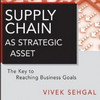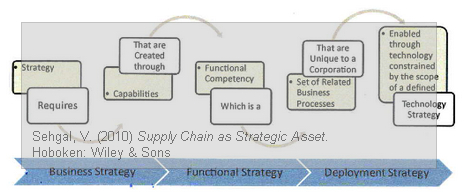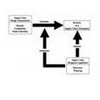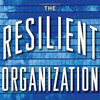 Is there something like a Supply Chain Nirvana, where it all comes together and where a firm’s supply chain is perfectly aligned with its business strategy, thus creating the competitive advantage the firms needs to stay ahead of its rivals? Vivek Sehgal may have found the recipe in his latest book, Supply Chain as Strategic Asset. In this tightly packed 300-page volume Sehgal shows how important it is to have a top-down-driven approach to supply chain management and how important it is to link strategy and execution, from the board room to the very last delivery guy. The supply chain is a firm’s core asset, and perhaps its most important asset, and a firm is only as good or as bad as its supply chain. While a bit overwhelming at first, this book is filled with many important real-life lessons, and K-Mart versus Wal-Mart seems to be one of Sehgal’s favorite subjects.
Is there something like a Supply Chain Nirvana, where it all comes together and where a firm’s supply chain is perfectly aligned with its business strategy, thus creating the competitive advantage the firms needs to stay ahead of its rivals? Vivek Sehgal may have found the recipe in his latest book, Supply Chain as Strategic Asset. In this tightly packed 300-page volume Sehgal shows how important it is to have a top-down-driven approach to supply chain management and how important it is to link strategy and execution, from the board room to the very last delivery guy. The supply chain is a firm’s core asset, and perhaps its most important asset, and a firm is only as good or as bad as its supply chain. While a bit overwhelming at first, this book is filled with many important real-life lessons, and K-Mart versus Wal-Mart seems to be one of Sehgal’s favorite subjects.
The sequel
In a sense, this book is the sequel to a previous book by Vivek Sehgal, Enterprise Supply Chain Management, a book that fully covers the complete setup of a supply chain from A to Z, with nothing left out, and while strategic considerations are not explicitly mentioned, implicitly they are taken care of. In the most recent book, the focus is explicitly on strategy.
Think before you act
Vivek Sehgal has a penchant for Porter’s Five Forces and Porter’s three generic strategies, which form the backbone of his theoretical underpinning. Everything new after Porter is just old wine in new bottles. Well, maybe not, but Sehgal spends a number of pages discussing how the “modern” supply chain strategies, such as lean and agile or speculation and postponement are nothing more than Porter’s cost leadership or segmentation/differentiation respectively. While I don’t agree 100%, the argument made by Sehgal is nonetheless very convincing. He may be right, because the more generic a strategy is the better it is for each firm to adapt a strategy to its own needs. Each firm must to find its own unique and specific strategy and its own and unique supply chain. That is at the heart of Sehgal’s message. Instead of jumping on any fancy supply chain management bandwagon, companies need to develop and deploy their own strategies, their own capabilities, their own competencies and their own business processes that are unique to them, not copy others, and Sehgal goes a long way in show exactly how this can be achieved.
Think, think, think
The book serves three purposes. Firstly it thoroughly explains the importance of having a clear business strategy. Secondly, it even more thoroughly explains how this business strategy must be translated into a functional strategy, which is then engraved into the supply chain using a deployment strategy. Well, not just the supply chain, in fact, the functional strategy needs a deployment strategy so that it can be injected into each and every business process to be successful. In short,
A strategy – requires capabilities – that must be created through – functional competency – which is a set of – related business processes – that are unique to a corporation – enabled through technology and constrained by the scope of a defined – technology strategy.

Sehgal’s book provides a roadmap for the thorough analysis and thoughtful decision-making necessary for aligning these three strategies.
Understanding strategy
The first 100-or-so pages are spent discussing strategy, what strategy is, and in particular how Porter’s three strategies affect businesses and supply chains. A bit tedious at first, but important in understanding how to form and how to execute a strategy.
No strategy, however brilliant, produces results unless executed.
In order to accomplish this, a strategy needs a set of key attributes: It must establish the destination. It must establish the direction. It must drive cross-functional capabilities. It must drive a feasible plan. It must be articulated. It must be adaptable. Moreover, a strategy must work on several levels, in time, in function and in impact. A strategy must work as a guiding, driving force. Many firms however, loose sight of their strategy along the way or rather, fail to align it all the way through. If the goal is to be the cost leader in your industry, customer service is perhaps not what you should spend too much effort on. If customer service excellence is your goal, the costs (and hence prices) ought perhaps not be of much concern, if the customers are willing to pay. You cannot have it both ways, that will always fail, as David Simchi-Levi wrote in his book, Operations Rules.
Concepts of business strategy
Sehgal reviews the current mainstream thinking on business strategy, in particular Porters three generic strategies cost, differentation and segmentation. Resource-based strategies and capabilities-based strategies are also reviewed, and examined using Porter’s model. Here, Sehgal shows how Porter’s way of thinking can help create competitive advantage regardless of which business strategy one subscribes to.
Functional strategy – the missing link
What a business strategy does for the business, a functional strategy does for the business function in question. Unfortunately however, the functional strategy is the missing link in most corporations’ strategic planning initaitives. While many firms may have a sense of direction for their business strategy, they are unable to translate that to the required business capabilities required to reach the desired goal, so Sehgal says.
Supply chain strategy
Understanding how the functional strategy works is essential to developing, honing and leveraging the supply chain function of a business. Interestingly, Sehgal dismisses the current mainstream supply strategies as true supply chain strategies, because they tend to drive the business strategy rather than being driven by it.
Is lean really a strategy for supply chains? The true answer is that lean is really a business model or a business strategy; in fact it is just another name for Porter’s cost strategy. Is agile a supply chain strategy? It sounds good as a concept, but it is hardly new thinking on supply chains. If a supply chain is not agile, it is simply not doing its most basic function of reacting to demand and supply changes in the environment.
Is speculation or postponement a supply chain strategy? Speculation is based on savings created through economies of scale through mass production and distribution. Postponement allows the manufacturer to personalize and configure finished products to customer orders, or to suit changes in customer demands, but postponement or speculation is not a choice, it is an imperative formed by the type of industry, assortment and demand patterns.
According to Sehgal, a supply chain strategy can only build on the supply chain sphere of influence, that is the four basic components of a a firm’s value chain: Demand, Supply, Inventory and Resources. These are the four components that actually drive the supply chain, and Sehgal details the Product, Industry, Business Strategy and Demand types that apply to each of these drivers.
Creating a Functional Supply Chain Strategy
A firm’s functional supply chain strategy depends on many factors: the industry segment, the business strategy and the supply chain design, each building on the former, with the latter being a result of the two first factors. Consequently the firm must consider the effect of its industry segment on supply chain design, the effect of its business strategy on supply chain design, and the effect of its primary driver on supply chain design. Not understanding the intricate and complementary relationship between business and supply chain strategies can lead to missed opportunities and conflicting investment priorities.
Supply Chain Nirvana
Unfortunately, so Sehgal says, there are no generic supply chain strategies that are equivalent to Porter’s generic business strategies, each firm must decide what is best for itself. Supply Chain Nirvana is only achieved when a firm defines a supply chain strategy that is right for it. There is no one “right” supply chain that fits all purposes. What is right for one corporation may be less or not at all desirable for another.
Supply chain nirvana is not a static state. It is a continuously evolving, but sustainable state of enhanced alignment of the supply chain capabilities with the objectives of the business strategy.
It sounds nice, but is it really achievable? After reading Sehgal’s book, I think it is.
Conclusion
I’ve always though of myself as strategist material more than manager material. Perhaps that is why I enjoyed reading this book. It is not a book that you can pick up at the airport and read on a long-haul flight and put into action on arrival. Nonetheless, it is a book that will make you think, and start wondering whether your business strategy is really in your supply chain or whether your supply chain is actually aligned with your business strategy at all. Are you driven by your strategy or by your supply chain? It is not a handbook in supply chain management, it is a book that using countless examples and anecdotes tells you that businesses are more than their strategies, businesses are more than their supply chains. Strategies and supply chains must come together for businesses to succeed. Martin Christopher said that supply chains compete, not companies. I’m inclined to add to that: Without the right strategy for support, supply chains cannot compete.
Reference
Sehgal, V. (2010). Supply Chain as Strategic Asset. The key to reaching Business Goals. Hoboken: Wiley & Sons.
Author link
- linkedin.com: Vivek Sehgal
- supplychainmusings.com: Vivek Sehgal’s own blog post about his book
Buy this book
- amazon.com: Supply Chain as Strategic Asset












